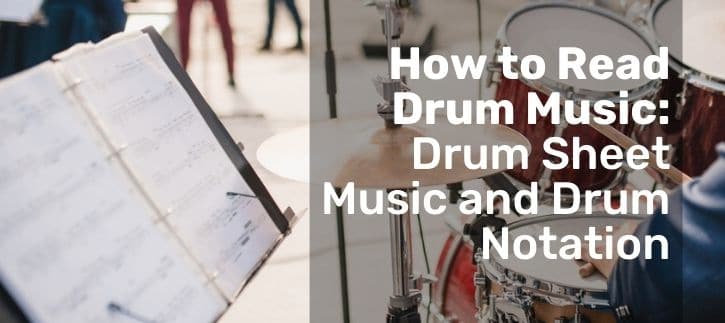The ability to read drum sheet music and drum notation is an art every aspiring drummer should learn. It is an incredible asset in your drumming career.
Proficiency in reading drum music helps you further your ability to play the kit. It can also help you secure a session gig, a role in a top-line band, or even an audition.
With this skill, you can play/ perform songs instantly without prior practice and play brand-new beats. It also helps you preserve your musical ideas without using any instrument.
Learning drum music is not as hard as it appears. It is much easier than learning a new language. Below is a simplified guide on how you can read drum music.
So how to read drum music quick?
Reading Drum Notation and Drum Sheet Music
Drum notation is different from drum sheet music though they appear similar and tend to use many related concepts.
The staff symbols in drum sheet music correspond to different notes. Whereas, the symbols in drum notation represent different parts of a drum set, like bass drum.
Basically, to learn drums is to understand rhythm and the needed coordination to play beats and fills.
Learning to read notations helps in knowing how to count music. It also enables you to understand which foot and hand play which note. Consequently, you perfect on control, which impacts your play speed, endurance, dynamics, and musicality.
In both drum notation and drum sheet music, the notes are written on the staff. Vertical bar lines then separate them.
The name of the space between the bar lines is a measure. Learning to read and write the staff gives you a strong sense of rhythm control and timing.
The Staff
It has five horizontal lines and five spaces. It is further divided into five different parts.

The Clef
It helps musicians and drummers to interpret a given staff
The Bar Line
It divides the staff into measures
Measure
It is the distance between two bar lines. Measures help you to stay on track with a particular piece and also helps in counting passages
Double Bar
It marks the end of a music section.
Single Line Staff
Some percussion scores use a single-line staff.
Drum Key Note Placement
You should read the drum notation from left to right. The notes can either be below or above the staff.

The placement of notes on the staff is dependent on the drum part you are playing at the moment. That is why, from our illustration above, the kick drum is in a different position from the ride cymbal or snare.
On the staff, dots signify drums while ‘x’ signifies cymbals.
The height of a note on the staff is similar to its location on a drum set. For instance, the bass drum notes are at the bottom, its usual place in a drum set.
Time Signature
In music, it is not logical to have endless lines of notes. It is, for this reason, that time signatures come to play.
Time signature resemble fractions from its writing.
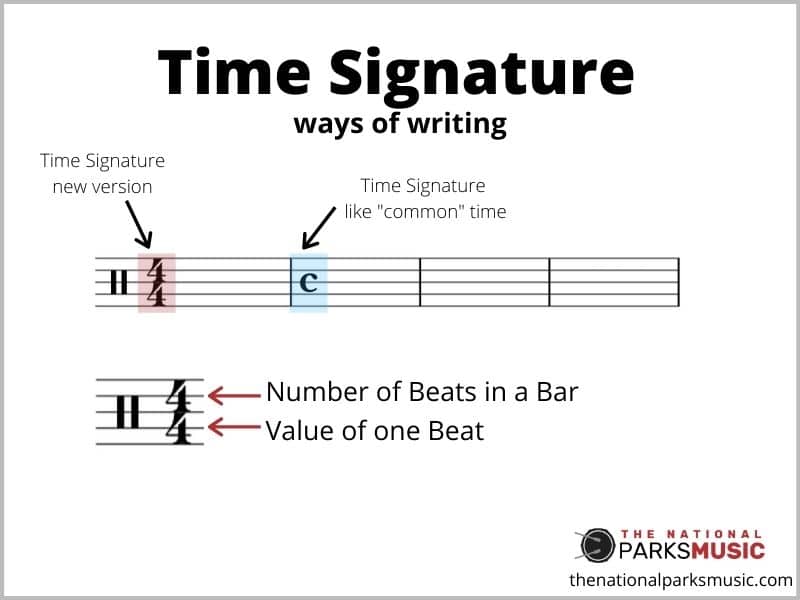
It appears at the beginning of every piece of drum music sheet. The number at the top represents the number of beats in each measure. From our example above, there are four beats to a measure.
The number at the bottom represents the size of the note/ the duration of each beat. We will discuss it in-depth as we proceed.
4/4 is a commonly used time signature, which signifies common time. Sometimes you will find it written as capital C in the staff.
Bars/ Measures
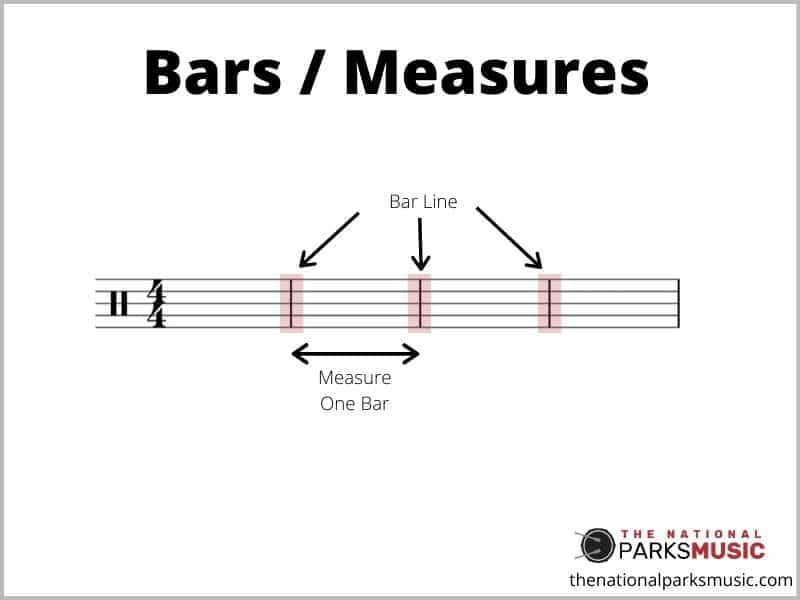
The above is a complete bar, with two bar lines illustrated by the arrows.
The significance of bars is to ease the reading and following of music. It is a simpler way of dividing up music. Anytime you lose your place in music, you can use the bar lines to navigate your way out.
Having very fewer notes, for instance, 4, is almost meaningless to your music. Four notes can last for a maximum of four seconds.
Too many notes are also not right. You would undoubtedly lose track, trying to count like 400 beats as you play drums at the same time.
Because of this confusion, a group of drum sheet music writers developed the bars/ measures. It comes in the form of vertical lines.
Through this, it is now possible to put 400 notes in a piece of drum sheet music. The notes would be broken down into 100 bars per measure, with four notes each. As such, you can enjoy countless minutes of music.
A group of bars put together forms a section. The label given to the section is either Verse and Chorus or A and B.
You can have a verse and chorus section of 16 bars each. Repeating this several times will give you an entire song.
Understanding Music Notes
There are different musical notations. Here is how they look like and how you can learn them.
For you to read sheet music drums, you need to distinguish the notes by how they appear.
Below is an illustration of what each note represents.
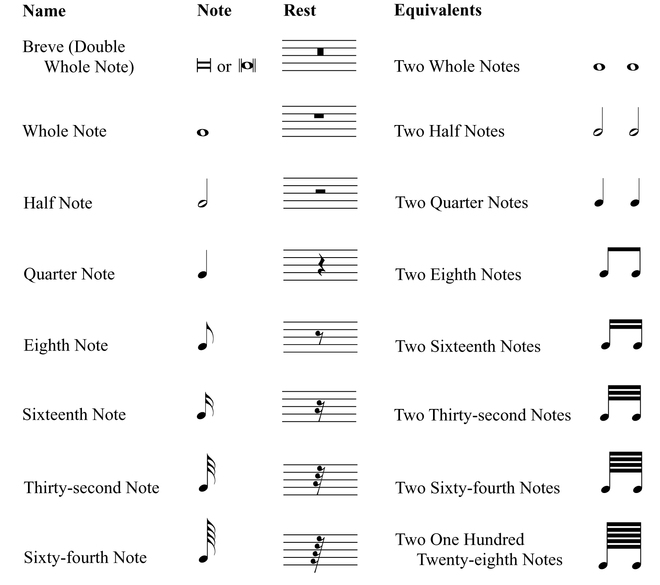
Sometimes, you can see a note or a rest having a small dot after it. In such scenarios, the note lasts 50% or 1/2 times longer than its standard length.
It is important to know that a combination of rests and notes is necessary for making rhythms.
Now, how do you play your drums after counting the 1 to 4 bars?
- Whole notes: When playing whole notes, hit a drum or cymbal on count 1. Then, wait for the other three beats so as to complete a total of four.
- Half notes: If playing half notes, hit the cymbal/ drum on count 1. Then, wait out count 2, hit again on count three, and wait out count 4.
Whole and half notes are vital in understanding how to read drum music. However, they rarely appear in actual drumming.
The rhythm pyramid below gives us a clear picture of how the drum notes are.
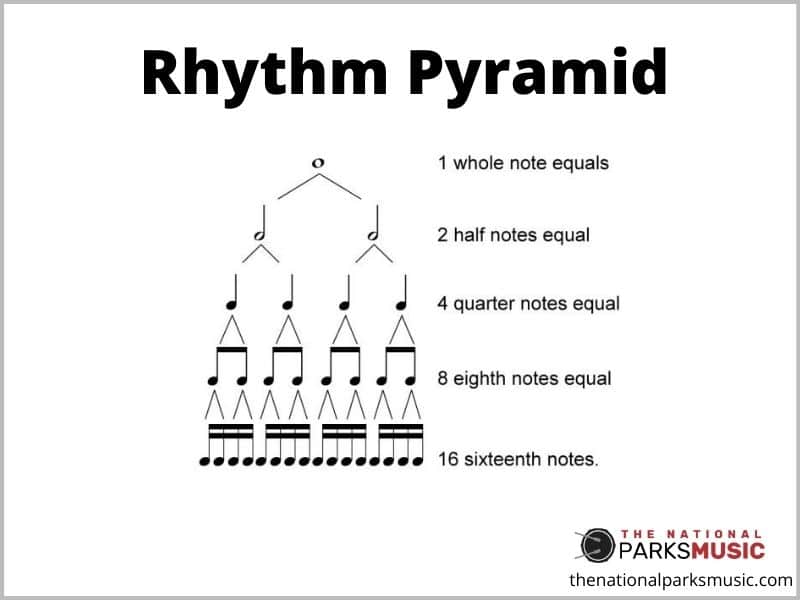
Whole Notes
They have note heads but no steam. A whole note’s duration equals to the amount of one measure.
Half Notes
In simple words, it is half of the whole note. In a 4/4 time, for instance, only two half notes are available for one measure duration.
Quarter Notes
In a 4/4 duration, there are four quarter notes in the staff bar. A quarter note takes up a single beat per count. You can count quarter notes as follows:

Eighth Notes
They only lasts half a beat for each count. As such, they end at the middle of counts one and two.
Determining mid-way is a bit challenging. You need to use a different counting system.
Instead of 1, 2, 3, 4, you now will count 1 and 2 and 3 and 4 and.
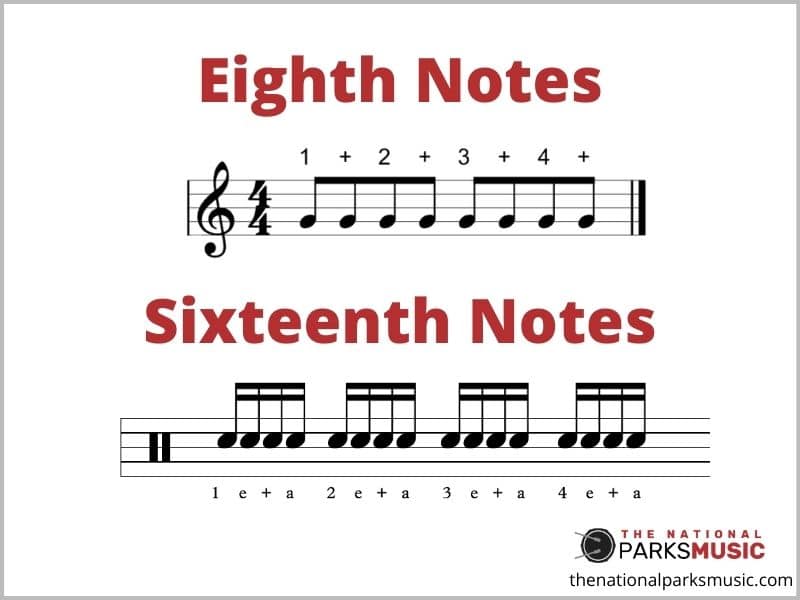
Sixteenth Notes
They are the shortest beats since they last for one-fourth of a beat. The counting system for this note further changes to:
1, e, and, a, 2, e, and, a, 3, e, and, a, 4, e, and, a. In a bar, you will have 16 such notes. They resemble the following in a drum sheet music:
The Rock Beat Groove
So far, so good. We are in our final stages of our drum lessons.
Now that you know how to read drum music sheets, a basic rock groove looks like the following.

You need to separate the drum and cymbal parts from the groove. The three main parts involved are the hi-hat, snare drum, and bass drum.
The upper, middle and lower parts are played on the hi-hat, snare drum, and bass drum, respectively.
How do you count and play the groove beats?
- The hi-hat
The hi-hat notation is in the eighth notes. Therefore, you shall use a similar formula to count and play as from our previous discussion.
The groove shall look as follows:

- The snare drum
On this bar, you play the snare twice, one time on count two and the other on count 4.
- The bass drum
To play a bass drum, you need to hit the kick pedal on counts 1, 3, and the ‘and.’
How to Read a Drum Fill
How do you count the above fill? It looks vague, right?

Let’s break it down to something simple. The drum fill above has 16 notes.
Counting 16 notes shouldn’t be difficult for you now since we discussed it earlier on. We shall still use the same formula – 1 e and a two e and a three e and a four e and a.
Our final fill shall look like:

Then, you need to separate the different parts as we did for the groove. The only difference with the drum fill is that each of the parts has four hits on a drum/ cymbal.
- One e + a takes four hits on the snare drum
- Two e + a takes four hits on the higher tom
- Three e + a takes four hits on the middle tom.
- Four e + a takes four hits on the lower bass drum tom.
Traditional vs. Modern Way of Reading Drum Music
Back in the day, reading drum sheet music and notation were incredibly challenging. The conventional method involved endless drum lessons and music theories.
You would draw out different notes without any idea of how they sounded like. You would only hear them if the tutor played or sang them for you.
Thanks to technology. Learning drum set musicals has significantly evolved at present. You can now get instant feedback on the sound of your sheet music.
You can also have drum lessons with a personal tutor 24/7, wherever you are. This teacher is a drum music notation software.
Getting a free trial drum music software is an excellent addition to this guide. It will make your learning process quick and fun.
The best thing about online software is that you are able to get instant feedback on any idea you write in drum sheet music.
It also allows you to check if you made any mistakes. Doing so speeds up your learning process since you can relate the notes on paper and the music on the drums.
Frequently Asked Questions
Do you need to read music to play drums?
No, you don’t need to read music to play a drum set. There are many self-taught drummers out there who are doing quite well. However, it takes them years of practice and listening to music to succeed by themselves.
If you want to perfect your drumming skills in a realistic time span, you should learn how to read music. Take as many drum lessons as possible.
How is music written for drums?
Most drums sheet music is written using a special notation software. The software facilitates the writing of different drum parts.
Usually, musical notations are written on the staff. It supports drum notes and drum rests as well as cymbals, a combination of these birth rhythms and songs.
What does a drum score look like?
A drum score looks like a fraction.
The top number represents the number of beats in each measure. The lower figure represents the size of the note per beat.
How do you read percussion music?
The first step towards reading percussion music is understanding drum notation. Familiarize yourself with the staff, note placement, and time signatures. An online drum notation software can be incredibly helpful if you want to know how to read drums fast.
Conclusion
If you are a serious drummer, you must endeavor to learn how to read drum music. It is the only way through which you can climb to the top of your career.
The ability to learn, read and write musical language gives you an upper hand over other drummers. With this skill, you can land amazing gigs in top line session bands.
You can play brand-new songs and beats instantly on any drum set. It helps you perfect control, speed, and endurance in drumming.
Reading drum music is not that difficult. You only need a few drum lessons and regular practice to perfect the art.
The basic things you must learn are the staff, note placement, music notes, bars, and measures. Also, master the art of counting beats, grooves, and drum fills.

